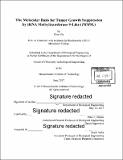| dc.contributor.advisor | Peter C. Dedon. | en_US |
| dc.contributor.author | Gu, Chen, Ph. D. Massachusetts Institute of Technology | en_US |
| dc.contributor.other | Massachusetts Institute of Technology. Department of Biological Engineering. | en_US |
| dc.date.accessioned | 2017-12-05T19:16:10Z | |
| dc.date.available | 2017-12-05T19:16:10Z | |
| dc.date.copyright | 2017 | en_US |
| dc.date.issued | 2017 | en_US |
| dc.identifier.uri | http://hdl.handle.net/1721.1/112512 | |
| dc.description | Thesis: Ph. D., Massachusetts Institute of Technology, Department of Biological Engineering, 2017. | en_US |
| dc.description | Cataloged from PDF version of thesis. | en_US |
| dc.description | Includes bibliographical references. | en_US |
| dc.description.abstract | The human tRNA methyltransferase 9-like (TRM9L) gene is a homolog of yeast Trm9 and human ALKBH8 and it has an important function in suppressing tumor growth in colorectal cancer. Loss of heterozygosity events on the Chromosome 8p22 loci, where TRM9L is located, are overrepresented in a wide variety of cancers, including prostate cancer, breast carcinoma, and hepatocellular carcinoma; downregulation of TRM9L expression is also observed in many different types of cancer. These findings implicate a general role potentially played by TRM9L in tumor suppression. A mechanistic understanding of TRM9L would have a broad impact in oncology. The broad objective of my thesis research is to connect mechanistically the biochemical function of TRM9L to its tumor suppressing activity. Of my special interest is TRM9L is regulated at the protein level. In this thesis, I demonstrated that TRM9L is a phosphoprotein, with phosphorylation dynamics at serines S214, S255, S279, S291, S306, and S380 correlated with protein-protein interactions and tumorigenicity. Phosphorylation levels were found to be modulated by stressors to which cells become resistant when TRM9L is silenced. For example, oxidative stress caused by hydrogen peroxide (H202) exposure increased phosphorylation on S255, S291, and S380, but phosphorylation was unchanged in response to ionizing radiation. Using chemical genetics approaches, I showed that phosphorylation of S380 is downstream of ribosomal protein S6 kinase (RSK), which is downstream of H202-activated extracellular signalregulated kinase (ERK). TRM9L mutations S214A, S255A and S380A significantly enhanced tumor growth, while S214A and S255A mutations also abolished a direct interaction between TRM9L and certain 14-3-3 isoforms. The results revealed a novel oxidative stress phosphosignaling regulatory mechanism underlying TRM9L's tumor suppressor behavior. I also demonstrated that TRM9L altered the ability of colorectal cancer cells to respond to stresses caused by reactive oxygen and nitrogen species. Results supported the idea that TRM9L reduces the cell's capacity to detoxify harmful reactive oxygen and nitrogen species and effectively makes them more toxic. Finally, my finding supported the notion that TRM9L expression downregulates the hypoxia-induced cell migration, presumably by controlling an aspect of epithelialmesenchymal transition (EMT). | en_US |
| dc.description.statementofresponsibility | by Chen Gu. | en_US |
| dc.format.extent | 129 pages | en_US |
| dc.language.iso | eng | en_US |
| dc.publisher | Massachusetts Institute of Technology | en_US |
| dc.rights | MIT theses are protected by copyright. They may be viewed, downloaded, or printed from this source but further reproduction or distribution in any format is prohibited without written permission. | en_US |
| dc.rights.uri | http://dspace.mit.edu/handle/1721.1/7582 | en_US |
| dc.subject | Biological Engineering. | en_US |
| dc.title | The molecular basis for tumor growth suppression by tRNA methyltransferase 9-like (TRM9L) | en_US |
| dc.type | Thesis | en_US |
| dc.description.degree | Ph. D. | en_US |
| dc.contributor.department | Massachusetts Institute of Technology. Department of Biological Engineering | |
| dc.identifier.oclc | 1011594971 | en_US |
